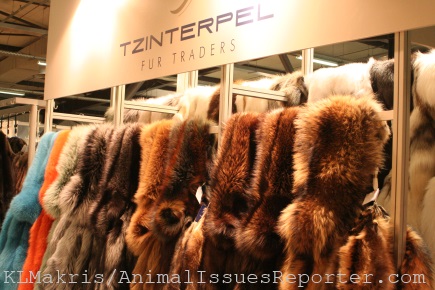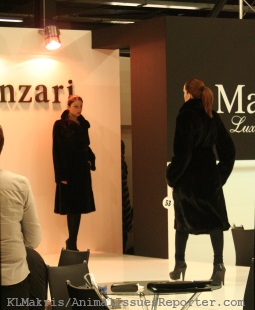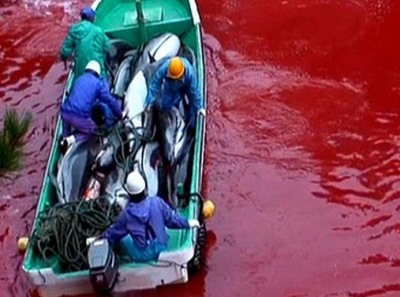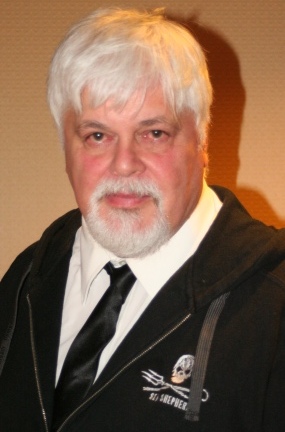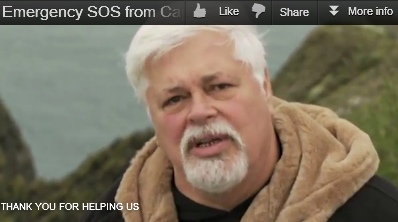by Katerina Lorenzatos Makris
Greece’s withered economy and confrontations with protestors do not deter hundreds of furriers from gathering every spring in a heavily-secured exhibition hall near Athens. They tempt primarily foreign buyers with swank display booths featuring leggy fashion models and thousands of garments made from the pelts of minks, foxes, and other animals.
As the fourth annual Athens Fur Fair approaches this year on March 27-30, Animal Issues Reporter Katerina Lorenzatos Makris takes a look back at her visit to the 2012 exhibition in this first of a series of articles including interviews with representatives from the fur industry and with animal advocates who oppose it.
‘Great success’
“’Fur Excellence in Athens 2012′ International Fur Fair finished with great success, in a critical moment for the fur industry due to the high prices in skins,” boasted a website of the Hellenic Association of Furriers, organizers of the event. “The turnover of the sales and orders placed during the exhibition is up to 30% compared to the last year’s exhibition… More than 1,700 business visitors, increased by 50% compared with those of the exhibition of 2011 visited the fair.”
Most of the buyers represented retailers from Russia, Ukraine, Siberia, Azerbaijan, Belarus, Latvia, Korea, and China, according to the website.
Hellenic Association of Furriers spokesman Nikos Panagioutou told Animal Issues Reporter (AIR) that one of the reasons for the fair’s success, even during one of the worst economic epochs in Greek history, was that it spanned four days compared to only three days in 2011, allowing for more attendance.
Describing his group as “a new association that represents the younger and the stronger fur companies in Greece,” he listed additional reasons why this year’s fair saw more activity: “Publicity, interest in the sector, and the quality of the participants.”
“Most of the biggest companies in Greece are here, and there’s a strong international presence [of buyers],” he said. “All this counts in favor of the fair.”
Current high fur prices don’t slow sales, because for this commodity quality matters more than price, Panagioutou explained, adding that Greek-made fur is world-renown for its exceptional craftsmanship and value.
Impact of anti-fur activism?
When asked if anti-fur industry campaigns by animal protection groups have any effect on the demand for the product, Panagioutou replied, “What is important is not so much the impact on the market. It is more important to me that they have beaten ten persons. They have dragged them out of their cars. And what happened with one person is that they threw on her plastic red paint. It has taken her months to recover from the shock.”
Panagioutou said the incidents occurred at the 2011 Athens fur fair.
An on-site police captain who declined to give his name told AIR that he was not aware of attendees ever having been dragged out of cars or being beaten at the annual event, but confirmed that activists had thrown or sprayed paint on exhibit-goers on Friday of the 2012 fair, and had verbally confronted drivers and passengers of cars as they exited the building.
Panhellenic Animal Welfare and Environmental Federation vice president Mariza Christodoulou, a leader of one of the groups of protestors, acknowledged that members of a different activist group had thrown paint at a Athens Fur Fair attendee, but denied Panagiotou’s claim that any protestors had ever beaten or dragged Athens Fur Fair participants out of their cars.
Tight security
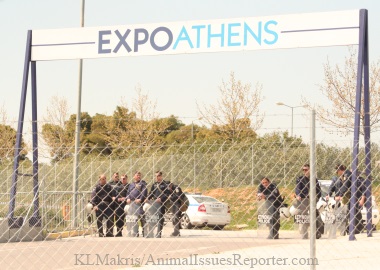
Police in riot gear kept protestors at a distance of several hundred meters away from the Athens Fur Fair exhibit center doors / Photo: Katerina Lorenzatos Makris
Security for the 2012 event, held at EXPO ATHENS in the northern suburb of Anthousa, was the tightest this reporter has ever encountered at a trade show. Several police officers stood watch around the building’s exterior. Attendants directed cars into a single driveway leading into garage parking. At pedestrian entrances to the building, all visitors’ hand-carried items such as purses and backpacks were subjected to searches as thorough as those made at many airports.
A security guard examining the contents of this reporter’s waist pouch pointed to a vinyl case for eyeglasses and asked, “Is that spray?”
More guards patrolled the exhibition halls, eyeing visitors to check for the official plastic badges required for admission.
On Saturday afternoon, about two dozen police officers—many armed in riot gear and carrying what appeared to be weapons for launching tear gas canisters—kept at bay an estimated 100 protestors belonging to various groups in a spot at least a five minute walk from the exhibition building.
Read the next article in this series: Animals killed cruelly ‘for money and vanity,’ say fur fair protestors
Get fresh AIR! Please click on the SUBSCRIBE button above to receive an email alert when we post new articles on animal issues, including the upcoming ones in our series about the fur industry:
‘Burn the fur industry,’ say Greek anti-speciesist protestors
Animals ‘should not be sacrificed on the altar of fashion,’ says fur fair protestor
Fur trade is important to Greek economy, says industry spokesman
Interview with Mariza Christodoulou, Vice President, Panhellenic Animal Welfare and Environmental Federation
Killing animals for fur is just as necessary as killing them for food, says industry spokesman
Interview with Olga Kikou, Coordinator, Animal Rights Group, Greek Green Party
Fur industry will grow despite animal advocates’ efforts to remove ‘freedom of choice,’ spokesman predicts
Interview with Thorbjørn Schiønning, Anima (Danish animal welfare group)
Visit to a fur farm in Denmark
Interview with Ann-Mona Kulsø Larsen, Nordgaard Fur Farm (Denmark)
Interview with Jan Helleskov, Communications Chief, Magasin du Nord (department store in Copenhagen that no longer sells fur)
Interview with Jens Birger Christensen, CO, Birger Christensen (furrier in Copenhagen)
Visit to Kopenhagen Fur
Katerina Lorenzatos Makris is a career journalist, author, and editor. Credits include hundreds of articles for regional wire services and for outlets such as National Geographic Traveler, The San Francisco Chronicle, Travelers’ Tales, NBC’s Petside.com, and Examiner.com (Animal Policy Examiner), a teleplay for CBS-TV, a short story for The Bark magazine, and 17 novels for Avon, E.P. Dutton, Simon and Schuster, and other major publishers.
Together with coauthor Shelley Frost, Katerina wrote a step-by-step guide for hands-on, in-the-trenches dog rescue, Your Adopted Dog: Everything You Need to Know About Rescuing and Caring for a Best Friend in Need (The Lyons Press).
Please respect copyright law. Sharing AIR links really helps! But copying more than a couple of paragraphs of content without permission is a no-no. If you’d like to use one of AIR’s articles or one of our photographs, kindly contact us at [airinfo AT yahoo DOT com].
Copyright © 2014 Animal Issues Reporter and AnimalIssuesReporter.com.
All rights reserved.
